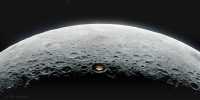After a week of speculation, China’s Long March 5B rocket landed in the Indian Ocean.
The location provided relief for those concerned about the wreckage landing in populated areas, and provided spectacular light show anticipation as most of the rockets ignited during re-entry. According to the Chinese Manned Space Engineering Office, the 30-meter (100-foot) long rocket re-entered the atmosphere at 11:11 pm on May 8 (2:24 UTC May 9), 72.47º easts, and 2.65º north, in the Maldives. The capital is located about 300 km southwest of Mala.
It is not yet known whether the Chinese Foreign Ministry’s confident forecast that most of the rockets will ignite in the atmosphere and that little debris is under threat has come true. However, a boat very unfortunately had to be in the exact right position to be hit by something it made with air. Fragments of former satellites, rockets and space junk often return to Earth. However, those weighing less than 10 tons are considered safe, as they ignite in the atmosphere.
Since 1990, heavy items have usually been brought down through controlled re-entry. In this case, however, the landing of the Long March was based on opportunity rather than good management – although the world’s surface0 percent of the land surface inequality with the sea was always good, this route would come out. Approximately 22.5 tons, the Long March is considered to be the eighth heaviest object for re-entry into the atmosphere and the fourth largest for uncontrolled entry. In 1979, the largest partial re-entry of the Skylab space station landed in a sparsely populated area in Western Australia.
The tumbling speed of the Long March rocket has made it difficult to accurately predict the time of its re-entry. However, with the probable time on Friday at 11:23 am (2:43 am UTC) and subsequent updates estimating 3:02 am ± 1 hour, the calculations prove to be close to the mark.
However, the speed at which the Long March 5B was traveling meant that a few minutes of uncertainty could take it thousands of kilometers to reach anywhere. After the wreckage of the rocket’s previous uncontrolled re-entry, the Chinese space program faced considerable criticism and did very little damage to the villages of Cote d’Ivoire and could easily kill or injure people.
It is not clear if any steps have been taken to prevent a recurrence, or if a failed attempt has been made. The rocket was used to launch the first module of the Tiangong space station. With about a dozen more launches planned over the next 18 months, we need to get into the habit of exploring the wreckage of space.















